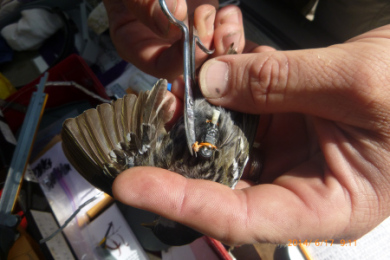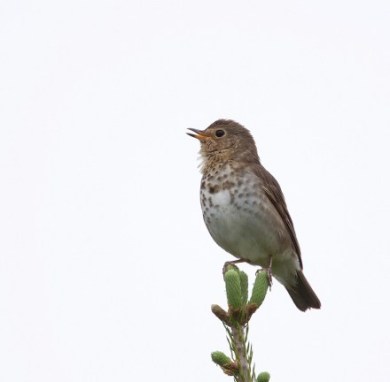Steve Faccio and I were back on VCE’s Mt. Mansfield ridgeline study site earlier this week. It’s always hard to believe at this time of year, but in early July, our field season is already winding down. Our primary objective for this trip was to retrieve a geolocator from a banded male Blackpoll Warbler that has taunted us around the parking lot, singing at maddeningly close range with the geolocator stalk visibly protruding from his back feathers. We arrived on Monday evening just after thunderstorms had swept across the mountain, which remained cloaked in clouds throughout the evening. Fortunately, additional rain held off for the most part, so we were able to set and open ~20 mist nets. Bicknell’s Thrushes (BITH) put on a strong vocal show, calling and singing more vigorously than during our visits of the past two weeks. This is typical behavior for early July, and it likely indicates that young have hatched in most nests.
The weather broke overnight, and we were treated to a spectacular
sunrise through low-hanging valley clouds. We had nets open by 4:30 am,
and the dawn chorus was robust. We applied our unique brand of “brute
force biology” (i.e., sheer persistence and dumb luck), managing to
capture our target Blackpoll in mid-morning and removing his
geolocator. The bird was in great shape, though likely glad to shed his
0.6-gram backpack. We have now recovered 3 of these light-gathering
devices, and our colleague Bill Deluca at UMass has done some
preliminary analyses of the data each geolocator gathered during the
past 12 months. Results are coarse, and many additional hours of
deciphering and interpretation will be required, but the broad pattern
points to an overwater southward flight from the New England coast, with
possible stops in the Great Antilles, and landfall in Venezuela, where
the birds overwintered. Spring migration appears to follow a route
through the Caribbean, then to Florida and along the coast to
Mansfield. Don’t bet the house on any of this, but the early results
are intriguing.
Activity in our mist nets was steady through the morning, and we ended
up with 35 captures, 15 of which were BITH, including a male banded in
mid-September 2011 as a young-of-the-year and recaptured in June of both
2012 and 2013. We’ve now captured 43 individual BITH so far this season
– 28 males and 15 females, 27 new birds and 16 returns from previous
years. By comparison, we captured a total of 37 BITH in 2013 (23 new
and 14 returns). Interestingly, of the 28 newly-banded BITH this
season, 22 (79%) are yearlings. We suspect that disruption of the
historically biennial fir-spruce cone cycle, which is tracked by red
squirrels and other avian nest predators, may be largely responsible for
this year’s relatively high numbers of BITH and other open-cup nesting
birds. This is the third consecutive summer following a low cone crop,
and we had not seen or heard a single squirrel on Mansfield until Steve
spied one on the Amherst Trail on Tuesday. Low squirrel populations
typically mean good nesting success, so we presume many BITH have been
produced during the past two summers, and will again be this year – thus
the influx of yearling recruits.
We’ve also netted relatively high numbers of Swainson’s Thrush (SWTH)
and Blackpoll Warbler (BLPW) on Mansfield so far this season. In fact,
we’ve crushed our previous record for SWTH (12 in 2012), with 16 already
captured (15 new, 1 banded in 2013), including 3 females in breeding
condition. BLPW captures already number 28 (23 new, 5 returns), with 7
females so far netted (we caught only 4 females and 24 males in 2013).
Other birds of interest on the ridgeline included a Red-eyed Vireo
singing briefly around the parking lot, a female Hermit Thrush (probably
a failed breeder or a bird that successfully fledged a first brood and
didn’t attempt #2), and an Ovenbird. The raven family from Smuggler’s
Notch entertained us with vocal and aerial antics through much of the
morning.
We’ll be back on Mansfield twice more this month, and again in
mid-September, hoping to recover 1 or 2 additional geolocators and hit
the half-century mark for BITH captures.


